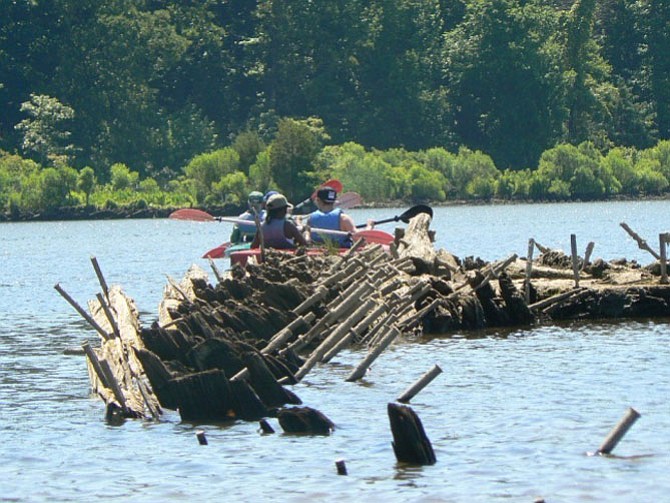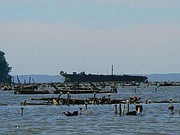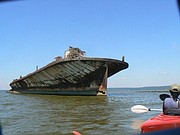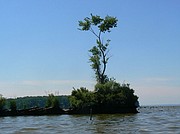Seaport Foundation kayakers ply the wrecks in the Mallows Bay shallows during an excursion June 21. Photo by Steve Mutty
Apprentices of the Alexandria Seaport Foundation traded in their workshop tools for kayaks June 21 when they got an up close look at Mallows Bay, the proposed National Marine Sanctuary along the Potomac River 30 miles south of Alexandria.
“The eagles at Mallows Bay were so close to us, I thought one might land on my kayak,” said ASF executive director Steve Mutty. “It was enthralling to see these birds up close.”
In Mallows Bay, the hulks of over 130 World War I-era wooden steamships share this patch of water with a thriving population of Bald Eagles, Ospreys and Great Blue Herons. There’s also a direct historical link between Mallows Bay and Alexandria.
Popularly known as the Mallows Bay Ghost Fleet, this collection of decaying ships along the banks of the Potomac are both a monument to post-war American enterprise and mismanagement. As WWI raged, the United Sates activated a plan to have ships built by the Emergency Fleet Corporation between 1917 and 1919 under the auspices of the United States Shipping Board. By the time most of them delivered, the war had ended and they were rendered obsolete before they were even put into service.
Many of the ships were towed to Alexandria for partial dismantling; their smokestacks, engines, equipment and metal for scrap were removed, then they were towed to Mallows Bay. For a time, there was an operation set up in a cove of Mallows Bay where wooden hulls were burned and the remaining scrap metal was recovered. This proved commercially unsuccessful and eventually shut down, but the ships kept coming. They stacked up in the rivers of the Chesapeake region, creating navigation hazards. Many found their final resting place when they were sunk in and around Mallows Bay.
The remains of the ghost fleet, which is the largest collection of wrecks in the Western hemisphere, has produced a unique combination of American Naval history and marine wildlife habitat. For that reason, Mallows Bay is working its way through the process of being designated a National Marine Sanctuary. It would be a first for the Chesapeake Bay region, as the next closest NMS is a day’s drive away. To the south, the USS Monitor NMS lies off the coast of North Carolina, while to the north, Stellwagen Bank NMS lies at the mouth of Massachusetts Bay, where humans and whales share one of the richest fishing grounds in North America.
Mutty organized last month’s excursion as an educational kayak trip to Mallows Bay for its apprentices, volunteers and staff. Twelve ASF kayakers were accompanied by two individuals who have been instrumental in moving the NMS nomination forward — Steve Bunker, formerly of The Nature Conservancy, has been the Charles County Government’s liaison to the U.S. Government on the National Marine Sanctuary designation; and Kim Hernandez, a coastal resource planner with the Maryland Department of Natural Resources Chesapeake and Coastal Service. They guided the group through dozens of wrecks in one of the main “boneyards” of Mallows Bay.
Above the water line, many of the wrecks are barely recognizable due to the overgrowth of trees, brush and a variety of plant life in summer bloom. Below the waterline, the wrecks are a natural attraction to fish. And, as Hernandez pointed out, “Where there are lots of fish in shallow water, birds of prey follow … and many of them nest in the vicinity to be close to their main source of food.” These include Osprey, Great Blue Heron and the Bald Eagle.
Mutty, a New England native, has spent every summer of his life within an hour’s boat ride of the Stellwagen Bank NMS, and has visited the area over a dozen times on whale watches. Whales aren’t here, but something equally iconic; “I had lived here in the D.C. area for 25 years before my first Bald Eagle sighting … through a strong pair of binoculars,” said Mutty.
In recognition of this assemblage of historical and natural resources in state waters, the State of Maryland, along with over 60 community partners, submitted a NMS nomination to the National Oceanic and Atmospheric Administration in September 2014. Since then, NOAA, the Maryland Historical Trust, the Department of Natural Resources, and Charles County have been working to draft a plan for how the area will be cooperatively managed, if designated a NMS. “The main purpose for NMS designation is to protect the historical resources in the area for future generations,” said Bunker, “but additional benefits include increased educational connections with public schools in the region, ecotourism, and small business opportunities.”
As the Seaporters came off the water from a 2-hour tour around Mallows Bay, they passed a group of more than 20 kayakers heading out on the water. “Excitement about the NMS nomination is running high,” said Bunker, “Both on-the-water activity at Mallows Bay and community interest has increased exponentially. This is a very big deal for the whole region, and we are especially eager to work with Alexandria historians to uncover more about its connection with Mallows Bay.”
Echoing that, Mutty said, “To have a National Marine Sanctuary less than an hour’s drive from Alexandria and D.C. would be a treasure.”



